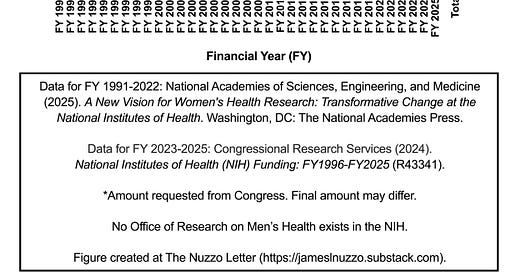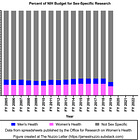This week’s graph shows the budget of the United States (U.S.) National Institutes of Health (NIH) Office of Research on Women’s Health (ORWH) from financial year (FY) 1991 to FY 2025. The pink bars display the budget for each FY. The pink bars are associated with the left y-axis and are measured in millions of dollars. The orange bar on the far right of the graph represents the total budget from FY 1991 to FY 2025. The orange bar is associated with the right y-axis and is measured in billions of dollars.
Key Points
The ORWH was established in 1990. Its first annual budget in FY 1991 was $1.2 million.
Throughout the 1990s, the ORWH had an annual budget of about $10-$20 million.
In the early 2000s, the annual budget of the ORWH increased to about $40 million. The budget remained at that level until FY 2021 after which the budget increased (under the Biden administration) to $76.5 million dollars in FY 2023 and FY 2024.
The NIH requested $153.9 million for the ORWH for FY 2025. The actual money received will be known at a later date. If these requested funds are included in the historical total for the ORWH, the total budget is $1.37 billion. If the requested funds for FY 2025 are excluded from the calculation, the total is $1.2 billion.
Sources
Congressional Research Services (2024). National Institutes of Health (NIH) Funding: FY1996-FY2025 (R43341).
National Academies of Sciences, Engineering, and Medicine (2025). A New Vision for Women's Health Research: Transformative Change at the National Institutes of Health. Washington, DC: The National Academies Press.
Office of Research on Women’s Health (2011). Moving Into the Future With New Dimensions and Strategies: A Vision for 2020 for Women’s Health Research. NIH Publication No. 10-7606. Page 26.
Bonus Commentary
Claims that women’s health is “underfunded” and “understudied” can be found in many news articles. These claims can also be found in other sources such as the National Academies of Sciences, Engineering, and Medicine’s report, A New Vision for Women's Health Research: Transformative Change at the National Institutes of Health.
In the report, the National Academies used claims of “underfunded” and “understudied” to argue for increased funding for women’s health research and for elevating the ORWH from its current role as coordinating center, where women’s health research initiatives are developed, directed, and co-funded, to that of a new Institute within the NIH.
However, the National Academies conveniently left out government data that refute their claim - i.e., the dollars spent on men’s health research. Namely, the National Academies did not mention the following:
Annual NIH funding for women’s health research is consistently $1-2 billion more than for men’s health research;
The $1 billion budgeted for the ORWH over the past 35 years is significantly more money than the zero dollars that were budgeted for the Office for Research on Men’s Health, which has never been created;
The U.S. federal bureaucracy houses 10 offices and committees on women’s health - some of which have their own budgets, including the Office on Women’s Health in the Department of Health and Human Services.
What’s more, this bias toward women’s health is happening while life expectancy in the U.S. is significantly shorter for males than females.
Related Content at The Nuzzo Letter
SUPPORT THE NUZZO LETTER
If you appreciated this content, please consider supporting The Nuzzo Letter with a one-time or recurring donation. Your support is greatly appreciated. It helps me to continue to work on independent research projects and fight for my evidence-based discourse. To donate, click the DonorBox logo. In two simple steps, you can donate using ApplePay, PayPal, or another service. Thank you!









Thanks James. It is hard to believe that this sort of thing has been going on for decades, but it has. And no one blinks. Instead they claim women are underfunded and understudied. You just can't make this stuff up.
Thank you, James. I will copy and paste you article into an email to the Congressional DOGE Caucus (DOGE@mail.house.gov). I will ask that they either cut funding to women's health in excess of that spent on men's health (which looks like it is zero dollars), or divide it in half, and give that to men's health.
I called up Congressman Bean (one of the three co-chairs of the DOGE Caucus) to follow up on previous notes I have sent them. I was told that they read EVERY email sent to them. So maybe we have half a chance.
Being that the National Academy of Sciences is involved in this injustice, I can ask the DOGE Caucus to look at them too.